Choosing the Best Dish Towel Material for Absorbency
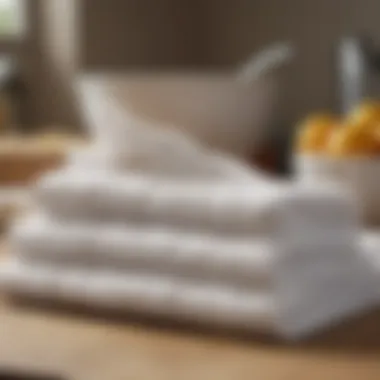
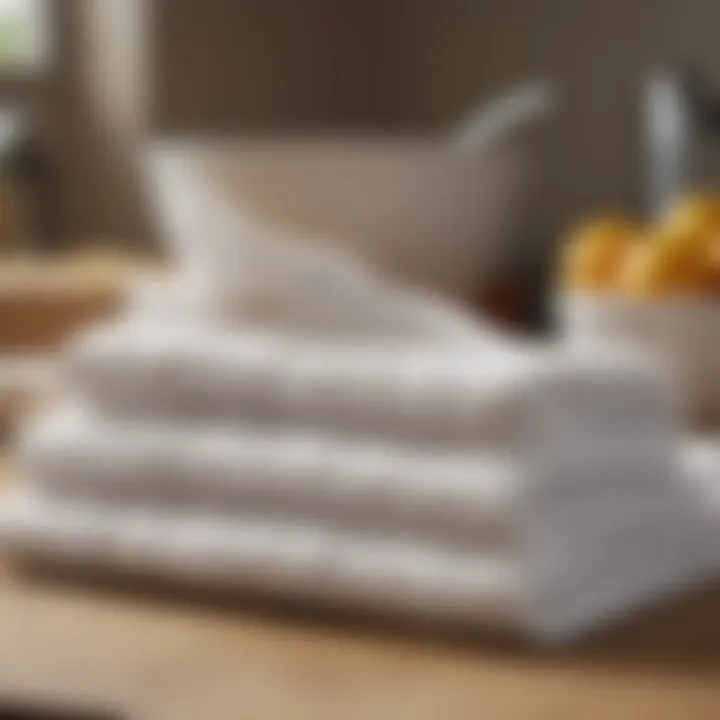
Intro
When it comes to managing the kitchen, your choice of dish towel material can make or break your experience. A good dish towel is more than just a pretty accessory; it’s a kitchen tool that plays a vital role in drying dishes, cleaning spills, and even handling hot cookware. In this analysis, we will look at the various types of materials used in dish towels, breaking down their unique properties, particularly absorbency, to help you make an informed decision.
In the culinary world, the most common materials are cotton, linen, microfiber, and bamboo. Each of these materials comes with its distinct set of attributes.
Key Points to Discuss
This article will delve into a few specific areas:
- Absorbency - Which material manages to soak up the most moisture?
- Durability - How do these materials hold up over time and with regular washing?
- Ease of Cleaning - What’s the best way to keep your dish towels fresh and stain-free?
- Heat Resistance - When handling hot dishes, which option will keep your hands safe?
- Eco-Friendliness - How do these materials fare in terms of their environmental impact?
By the end, you'll have a clearer picture of which dish towel material fits your kitchen needs best, setting you up for success in the culinary arena.
Understanding Absorbency in Dish Towels
Understanding absorbency in dish towels is crucial for anyone dabbling in the culinary arts or simply looking to maintain a tidy kitchen. The function of a dish towel extends beyond just drying dishes, sponges, or hands; its ability to effectively absorb moisture is what really sets these cloths apart. When you consider the various tasks that a dish towel could be put to—whether it’s wiping spills, drying utensils, or handling hot pots—the significance of absorbency becomes crystal clear.
Many might think that any towel will do, but the reality is that materials can vary greatly in their absorbent capabilities. This difference impacts both the functionality of the towel and the overall efficiency of your kitchen work. Selecting the right material based on absorbency helps in keeping the workspace hygienic and counterproductive messes at bay. It’s not just about preference but rather about enhancing the kitchen experience through informed choices.
What is Absorbency?
Absorbency represents a material's capacity to soak up liquids, which can be measured in several ways. It's often quantified by reading the volume of liquid a textile can take in relative to its weight. For instance, cotton generally has a high absorbency due to its ability to trap water in its fibers. However, absorbency isn't just about how much liquid a towel can hold; it also includes how quickly it can absorb and release moisture.
Key factors that influence absorbency include:
- Fiber Structure: Different fibers have unique structures that either facilitate or hinder liquid movement.
- Fabric Density: A denser fabric may hold more liquid, but too dense can slow down absorption.
- Surface Area: More surface area usually means more opportunity to soak up moisture.
Understanding these elements allows consumers to make wise selections that correlate with their specific kitchen needs.
The Importance of Absorbency in the Kitchen
In the kitchen, absorbency marries utility with convenience. A dish towel that excels at absorbing moisture saves time—no more resorting to multiple towels or cloths when one can do the job well. Plus, an absorbent towel can help in maintaining cleanliness by quickly soaking up spills before they become bigger messes.
- Hygiene: The quicker moisture is absorbed, the less time bacteria have to proliferate on surfaces and in between towel fibers.
- Efficiency: When a dish towel can quickly absorb water, it means you get more work done without interrupting your flow.
- Versatility: High absorbency allows for a multi-tasking action that towels can provide. From drying hands to cleaning countertops, a good dish towel earns its keep.
Any cook knows the hassle of a flimsy towel that can't handle simple spills or gabs. Thus, investing in a towel with excellent absorbent properties is a smart move; it contributes to a more effective and enjoyable cooking experience.
"A wet environment invites trouble; a super absorbent towel keeps the kitchen fresh and efficient!"
In summary, absorbency is an essential characteristic of dish towels that influences both their utility and hygiene. As we move through the various materials in the subsequent sections, it will be evident how absorbency plays a pivotal role in selecting the best dish towel for each unique culinary context.
Overview of Common Materials Used
When it comes to dish towels, the choice of material plays a significant role in their absorbency and overall performance in the kitchen. Understanding the different types of materials can help chefs and home cooks alike make informed decisions based on their specific needs.
This section will explore four primary materials commonly found in dish towels: cotton, linen, microfiber, and bamboo. Each of these materials brings unique attributes to the table, along with specific advantages and disadvantages.
Cotton
Cotton dish towels are the classic choice for many households. Known for their excellent absorbency, cotton can soak up spills effortlessly. The fibers in cotton allow it to hold up to 25 times its weight in water, making it a popular option for drying dishes or wiping countertops. They are also very soft, which means they won't scratch surfaces or delicate dishware.
However, it's worth noting that not all cotton dish towels are created equal. The quality can vary significantly based on the thread count and weave. A tighter weave often results in better durability and absorbency. On the flip side, cotton can lose its effectiveness after several washes, especially if fabric softeners are used, which can create a film that reduces absorbency. For those who prioritize both performance and ease of cleaning, 100% cotton towels should be on the radar.
Linen
Linen, made from flax fibers, stands out for its unique absorbency traits. It's known to be more absorbent than cotton initially, absorbing moisture quickly. One interesting aspect of linen is that it becomes softer and more absorbent with each wash, rather like fine wine improving over time.
However, maintaining linen can be a bit tricky. It creases easily, and some might find ironing necessary to keep a tidy appearance. Additionally, it's essential to avoid high heat during laundering because it can weaken the fibers. Even with these challenges, linen towels add an aesthetic touch with their elegant, rustic charm. They often come in subtle colors and patterns, complementing a kitchen's decor beautifully.
Microfiber
Microfiber dish towels are a modern marvel in kitchen cleanliness. The small fibers create an extensive surface area, allowing these towels to capture more dirt, grime, and moisture than their cotton counterparts. It’s this super absorbent nature that makes them great for both drying dishes and cleaning surfaces.
One significant advantage is that microfiber can be washed frequently without losing its absorbency. They are resistant to mold and mildew, making hygiene less of a worry over time. However, some cooks might feel that microfiber doesn’t offer the same “homey” feel that natural materials do. It’s also crucial to wash microfiber separately from other fabrics to prevent lint buildup—because nothing's worse than a towel that leaves fuzz on your clean dishes.
Bamboo
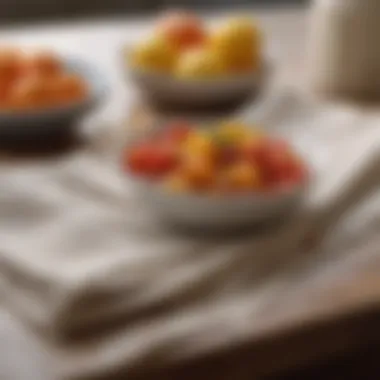
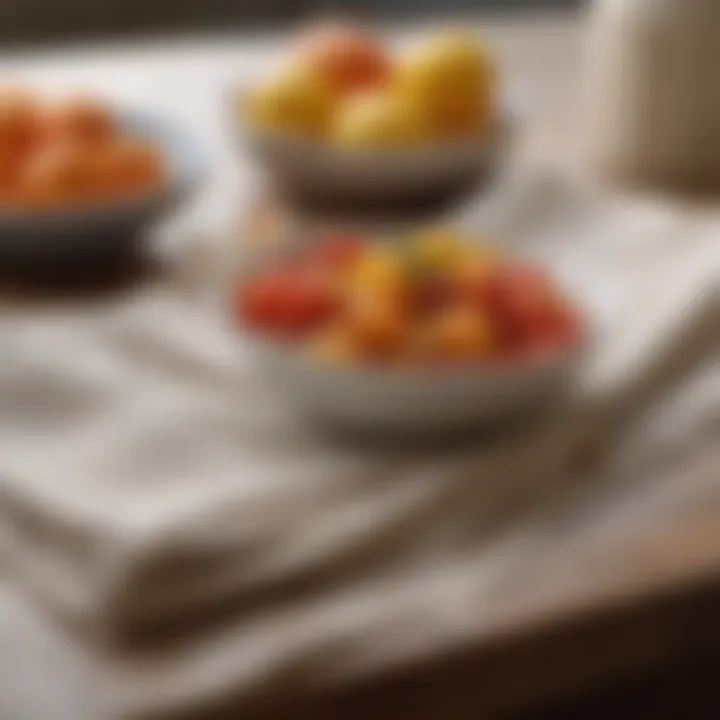
Bamboo dish towels are a rising star in eco-friendly kitchenware. Made from fast-growing bamboo plants, these towels boast naturally antibacterial properties. This means they can fend off germs more effectively and stay fresher longer. Moreover, they are both absorbent and gentle, offering a soft touch that won't scratch surfaces.
Even still, bamboo towels can be more costly compared to conventional cotton or microfiber options. Additionally, their maintenance requires careful attention to washing instructions to preserve their quality. With sustainable practices becoming more vital in our daily lives, bamboo towels appeal to those looking to reduce their environmental footprint while keeping their kitchens functional.
"Choosing the correct dish towel material isn’t just about absorbency; it’s also about durability, aesthetics, and sustainability."
In summary, understanding these materials allows for an informed choice when selecting the right dish towels for any kitchen. With varying levels of absorbency, care requirements, and aesthetic qualities, being aware of what each option provides is essential for any devoted home cook.
Examining Cotton Dish Towels
When it comes to dish towels, cotton is a heavyweight contender. Not only is it widely used, but it also has a knack for tackling a variety of kitchen tasks effectively. This section dives into why examining cotton dish towels is crucial for anyone looking to enhance their culinary space. With its blend of absorbency, ease of care, and cost-effectiveness, cotton stands tall among competitors. Let's break down the unique characteristics that make cotton dish towels a staple.
Absorbency Characteristics
Cotton dish towels are revered for their superior absorbency. Made of natural fibers, cotton can hold up to 27 times its weight in water. This remarkable ability makes it perfect for soaking up spills or drying dishes after a good wash. The structure of cotton fibers allows them to form tiny spaces that trap moisture, creating a sponge-like effect.
- They effectively absorb grease and liquids alike.
- Great for drying hands or wiping countertops after cooking.
- Perfectly suited for any kitchen task, from rinsing fresh produce to cleaning glassware.
However, not all cotton dish towels are created equal. The weave and quality of the cotton can influence absorbent capabilities. For instance, terry cloth, known for its looped texture, is excellent for absorbing moisture. On the other hand, a tighter weave might perform adequately but could leave a bit more moisture behind.
Durability and Care
Cotton dish towels tend to be pretty resilient, handling a multitude of washes while staying relatively intact. An important aspect to note is that they can withstand high temperatures, making them suitable for sanitizing in hot water. Unlike some synthetic materials, cotton does not melt or warp, maintaining its form over time.
However, the care of cotton towels does come with its own set of considerations. Frequent washes can lead to wear and tear. Yet there’s a silver lining here. Cotton is naturally resistant to staining, and most of its stains are easily removed with a simple wash in hot water. To prolong their life:
- Avoid fabric softeners which can coat the fibers, reducing absorbency.
- Line drying can help retain their natural fluffiness.
- Regularly bleach whites to keep them looking crisp and fresh.
Cost-Effectiveness
Let's talk turkey about the cost of cotton dish towels. Generally, they offer a good bang for your buck. Given their longevity and absorbency, investing in high-quality cotton dish towels can be a smart move economically. While high-thread-count options may come with a steeper price tag, they often prove more durable and effective in the long run.
In terms of practicality, you might find yourself reaching for them day in and day out. This consistent use translates to fewer replacements, making cotton a wise financial choice in kitchen essentials.
Ultimately, the cost-effectiveness of cotton dish towels goes hand-in-hand with the convenience they bring to everyday kitchen tasks. Whether drying the last set of plates or wiping a sticky surface, these towels are sure to hold their own.
"Investing in quality cotton dish towels means you’re not just buying a piece of cloth; you’re choosing a reliable partner in your culinary adventures!"
With these insights into cotton dish towels, it’s easy to see why they’re a household favorite. From their absorbent nature to their durability and overall cost-effectiveness, cotton dish towels deserve a spot in every kitchen.
Exploring Linen Dish Towels
Linen dish towels can be a bit like that old friend you haven’t seen in ages; you remember their unique quirks, and upon reuniting, there’s a comfort in their familiarity despite the challenges they bring. Known for their high absorbency, durability, and natural luster, linen towels can elevate the kitchen experience when chosen wisely. This section dissects the characteristics of linen dish towels, shining a light on their strengths and the considerations you might want to keep in mind before inviting them into your culinary space.
Unique Absorbency Traits
Linen stands out from its cotton counterparts primarily due to its structure. The fibers in linen, spun from the flax plant, are naturally hollow. This unique quality allows linen to quickly wick away moisture, making it exceptionally absorbent. It can handle spills or drying dishes without leaving pesky lint behind, ensuring a spotless finish on your glassware.
Moreover, some might argue that the absorbency of linen only improves with washing. With each round in the laundry, linen becomes softer and even more efficient at soaking up water. Overall, if you are after a towel that performs remarkably in liquid retention, linen dish towels will not disappoint.
Maintenance Challenges
However, maintaining linen dish towels can feel like herding cats at times. They have a tendency to crease easily, which might not be everyone’s cup of tea. While linen naturally fights off odors and bacteria, it does require a bit more care in washing. Hot water and prolonged exposure to detergents can wear the fabric down faster than a hasty cooking session can create a mess.
Additionally, linen can shrink after a hot wash or drying cycle. So, if you’re someone who’s in a hurry and often throws in a mixed load, think twice before adding those new linen towels with other high-maintenance fabrics. To keep your linen towels in tip-top shape, air drying is recommended instead of high heat, as it helps preserve the fibers.
Aesthetic and Functional Benefits
On the aesthetic front, linen brings an air of sophistication to any kitchen. Available in a spectrum of colors and textures, these towels can not only be functional but also serve as a decorative touch. Their rustic charm fits well with most kitchen designs, blending practicality with flair.
In terms of functionality, linen dish towels offer versatility. You can use them to dry dishes, cover bread while it rises, or even line a serving bowl. Plus, their durability means you won’t be running to the store for replacements any time soon.
Microfiber Dish Towels and Their Absorbency
When it comes to the kitchen, the choice of dish towel can make a world of difference. Microfiber dish towels stand out due to their exceptional capabilities. They don’t just dry; they absorb moisture like a sponge. This section digs deep into why microfiber dish towels deserve a prominent spot in your kitchen arsenal.
Super Absorbent Nature
Microfiber's absorbency stems from its synthetic fibers, which are finer than human hair. This unique structure allows them to soak up several times their weight in water. Unlike traditional cotton towels, microfiber’s intricate weave creates a larger surface area for water absorption. If you do some calculations, you'll find microfiber can hold up to seven times its weight in liquid. This impressive performance translates into a dish towel that works harder and dries dishes quicker.
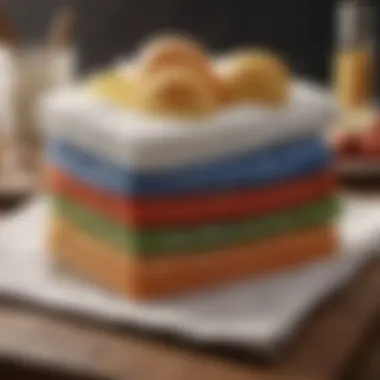
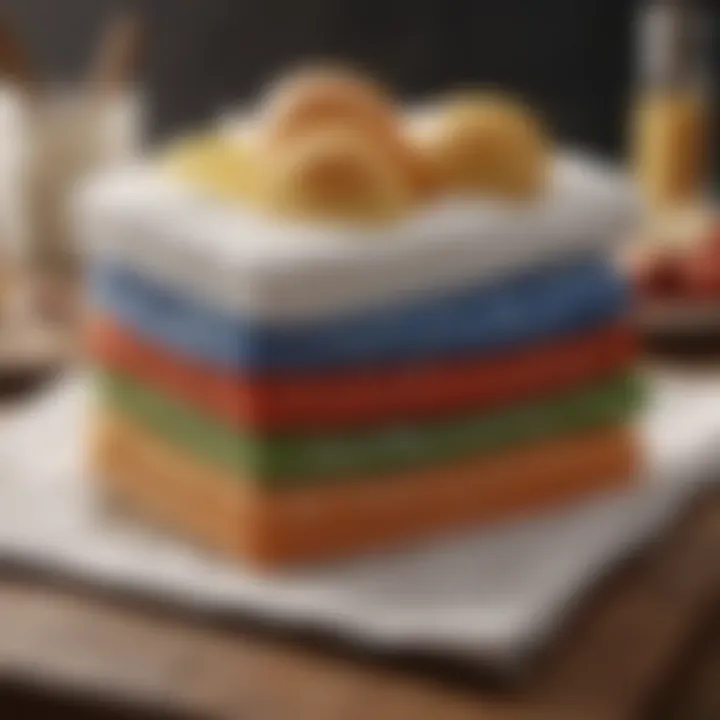
"A good microfiber towel is like having a tiny cleanup crew right at your fingertips, prepared for that unexpected spill!"
This superb absorbent quality particularly shines when dealing with greasy dishes or moist hands. Unlike cotton, which can spread moisture around, microfiber locks it away. So, no more half-dried plates and cutlery with streaks from shoddy towels.
Cleaning and Maintenance
Caring for microfiber dish towels is straightforward, which makes them user-friendly. Just toss them in the washing machine, and they come out fresh as a daisy. Avoid fabric softeners, as they can coat the fibers and impair absorbency. Instead, use a mild detergent to maintain their efficiency. Drying microfiber can be done in the dryer, but low heat is key. High heat can damage the fibers over time.
Furthermore, these towels dry quickly compared to cotton ones. When you wash a set of cotton towels, they can take longer to dry, leaving them damp and possibly breeding ground for bacteria. Microfiber, on the other hand, releases moisture swiftly, easing the task of kitchen upkeep.
Versatility in Use
Microfiber is not just a one-trick pony; its versatility is worth noting. Beyond drying dishes, these towels can handle a plethora of tasks. They can be utilized to clean countertops, windows, and even car interiors, thanks to their non-abrasive nature. Their ability to attract dust and allergens makes them great for housekeeping too.
In culinary terms, this means you can use microfiber towels for everything from drying hands to wiping up spills without worrying about cross-contamination that you might experience with a more traditional fabric.
In summary, microfiber dish towels earn their place as a top choice for any kitchen. With their super absorbent nature, simple cleaning, and versatile applications, they make daily kitchen tasks a whole lot easier. As you consider what kind of materials suit your needs, keep in mind that microfiber may very well be the laundry list you didn’t know you needed.
Bamboo Dish Towels: An Eco-Friendly Option
Bamboo dish towels have garnered significant attention as an eco-friendly option in the realm of kitchen textiles. More and more folks are searching for sustainable alternatives to everyday items. Bamboo is not just trendy; it’s practical. It brings its unique qualities that cater not only to absorbency but also to various other environmental considerations. Given the rise in conscience about environmental footprints, having options like bamboo towels is both timely and relevant.
Natural Absorbency Factors
Bamboo is known for its natural absorbency, making it an ideal choice for dish towels. The fibers of bamboo can absorb nearly three times their weight in water. This means you can dry dishes quickly without needing to wring them out constantly. That's quite the advantage in a bustling kitchen where time is of the essence. Additionally, bamboo fibers are naturally porous, enhancing their drying capabilities. Less moisture retention means you're less likely to end up with musty odors, which is always a plus.
- High Absorbency: Bamboo can soak up liquids efficiently, which is crucial for a dish towel.
- Fast Drying: Due to the porous nature, these towels dry faster than many cotton counterparts, reducing the likelihood of bacteria buildup.
- Soft Texture: The fibers create a soft texture that’s gentle on dishes, protecting delicate china or glassware from scratches while still doing a solid job of drying.
Sustainability Considerations
When discussing bamboo, one can hardly ignore its sustainable attributes. Bamboo is a rapidly renewable resource—growing up to 36 inches in a single day without the need for fertilizers or pesticides. This makes it an appealing choice for environmentally-conscious consumers. Furthermore, bamboo absorbs more carbon dioxide and releases more oxygen compared to many trees, contributing positively to the overall atmosphere.
- Water Usage: Growing bamboo uses significantly less water than traditional crops, like cotton. This is another green feather in its cap.
- Biodegradability: At the end of its lifespan, bamboo towels can decompose much more efficiently than synthetic fibers, ensuring that they leave behind a smaller environmental footprint.
- Reduction in Deforestation: By utilizing bamboo, the pressure on tree populations decreases, potentially helping to maintain forest areas.
"Bamboo isn't just a plant; it's a game-changing option for those who are serious about sustainability products."
Longevity and Cost Analysis
One might wonder about the longevity of bamboo towels versus other materials. The truth is they tend to hold up quite well over time. If cared for properly, bamboo towels can last for a significant period. They can withstand multiple washes, maintaining both their absorbent qualities and softness. However, they should be washed in gentle cycles and allowed to air dry whenever possible to maximize their lifespan.
Despite their many benefits, bamboo towels sometimes carry a higher price tag compared to conventional dish towels. Consumers should weigh the upfront investment against the longer-term benefits.
- Durability Score: While some bamboo towels may wear out faster due to light materials, others are crafted with tightly woven fibers for durability.
- Initial Cost vs Replacement: Consider how often you may need to replace cheaper options. Investing upfront can save you money over time.
- Total Value: Factor in not just the cost but also the environmental impact and your health when choosing the right towel.
Choosing bamboo dish towels may come with some nuances in terms of price, but their advantages in absorbency, sustainability, and longevity tell a compelling story for eco-aware consumers.
Comparative Analysis of Dish Towel Materials
Understanding the diverse materials available for dish towels can significantly shape the cooking experience. Each material, from cotton to bamboo, presents unique advantages and disadvantages that may affect both functionality and aesthetic in the kitchen. A comparative analysis allows one to not only gauge absorbency but also delve into durability, longevity, and cost-effectiveness. This section addresses the critical aspects that influence the choice of dish towel material, vital for anyone who spends time preparing meals or simply cleaning up afterwards.
Side-by-Side Absorbency Testing
When assessing the absorbency of dish towels, direct comparison can yield illuminating results. Different materials exhibit varying capacities for soaking up liquid, hence it’s essential to conduct side-by-side tests.
For instance, if you take a standard cotton towel and pit it against a microfiber option, you'll notice some striking distinctions. Cotton can absorb a fair amount of liquid, but microfiber often comes out on top due to its unique structure, which enables it to hold up to seven times its weight in water.
During testing, consider some key aspects:
- Amount of Water: Measure how much liquid is absorbed by each towel after immersing it.
- Drying Speed: Allow each towel to dry after the initial soak; see which one dries faster.
- Feel: Take note of how each towel feels after absorbing water; is it heavy and soggy or light and manageable?
"Absorbency is more than just capability; it’s about efficiency and ease in the kitchen."
Durability and Wear Over Time
Durability can often be an overlooked quality in dish towels. While absorbency might catch your attention, it’s the longevity of the materials that ultimately sustains value. Cotton, for example, while quite absorbent, may fray or grow thin after repeated washings. Linen tends to stand up over time but has its nuances, like wrinkling. Microfiber can endure many wash cycles without losing its structure, a time-saver in the long run.
A comparison of durability should take into account:
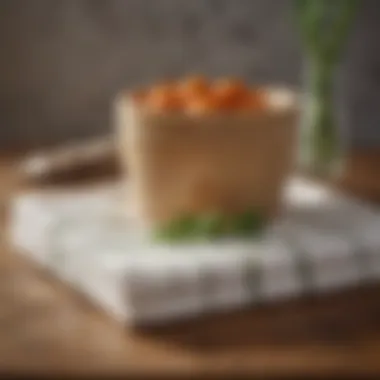

- Washing Frequency and Conditions: Different materials react uniquely to washing, which can build or wear down absorbency.
- Usage Patterns: Frequent part of meal prep, cleaning, or simply drying hands will affect how long a dish towel lasts.
- Fiber Integrity: Assess how well the fibers hold together after extended use.
Cost vs. Performance Evaluation
Finally, when it comes to kitchen gear, price and performance often go hand in hand. This segment sheds light on how much you’re willing to spend versus what you get in terms of quality.
Examining materials like cotton or linen might seem cost-effective at first glance, with lower price points enticing buyers. However, over time, the performance—especially in terms of absorbency and durability—might justify the investment in microfiber or bamboo towels, which, despite a higher upfront cost, can offer better performance and longevity. Things to weigh include:
- Initial Investment vs. Replacement Costs: Calculate how many lower-cost towels you may need to buy versus investing in a higher-end option.
- Performance Metrics: Take into account the absorbency and durability stats against the price.
- Overall User Experience: Which towel performs better under kitchen stress, making your tasks less cumbersome?
By systematically comparing these materials through side-by-side absorbency tests, examining durability, and considering cost versus performance, readers can gain a holistic view of dish towel options available to them. Making informed choices will ultimately enhance their culinary endeavors.
Choosing the Right Dish Towel Material for You
Choosing the right dish towel material is crucial in ensuring a smooth and efficient cooking and cleaning experience. It may seem low on the radar compared to other kitchen gear, but having the right towel at your fingertips can save time, reduce frustration, and elevate the overall kitchen atmosphere. With various materials offering distinct properties, selecting the most suitable one hinges on understanding your unique kitchen needs, personal style, and financial situation.
Assessing Kitchen Needs and Usage
When it comes to choosing a dish towel, you first need to consider the frequency and type of usage. Ask yourself how often you cook and what tasks you’d like the towel to assist with. Do you primarily need it for drying dishes, cleaning surfaces, or perhaps handling hot pots? For instance, if your culinary escapades often involve greasy hands or wet dishes, a super absorbent towel made from microfiber or cotton could be your best bet.
Here’s a little breakdown to help clarify:
- Daily Use: If you find yourself washing dishes daily, a soft, absorbent cotton towel might serve your needs well.
- Occasional Baker?: For those who love baking, having a linen option can keep things stylish while still soaking up moisture.
- Eco-Conscious User: If sustainability is essential, bamboo towels offer a green alternative without sacrificing performance.
In essence, aligning your choice with your kitchen habits ensures that you have a reliable tool ready to tackle any mess that comes your way.
Balancing Absorbency with Aesthetics
Functionality is a given, but aesthetics shouldn’t be brushed aside either. The visual appeal of dish towels can either elevate your kitchen’s decor or clash with it entirely. Thus, it’s key to strike a balance between absorbency and how the towel looks hanging on your oven handle.
Consider the following:
- Color Coordination: Going for neutral colors can match with almost any kitchen design, making them a safe choice.
- Patterns and Textures: A patterned towel can add a splash of personality, perhaps a fun print that resonates with your cooking style.
- Sturdiness vs. Look: Some towels look good but may not hold up as well when the rubber meets the road—or in this case, when cleaning messes.
Ultimately, a well-chosen towel can be a seamless blend of utility and style, ensuring it complements your unique kitchen vibe while performing its duties efficiently.
Financial Considerations
Let’s face it, the budget plays a massive role in any purchasing decision. Dish towels range widely in price, and while it might be tempting to lean towards the cheaper options, keep in mind that you often get what you pay for. Investing in durable and effective dish towels can pay off over time.
When pondering your budget, here are some points to ponder:
- Quality vs. Quantity: Sometimes it pays to splurge on a few high-quality towels rather than a bulk of cheap ones that don’t hold up.
- Long-Term Savings: Consider the lifespan of the towel; a towel that lasts longer means fewer replacements.
- Sales and Offers: Keep an eye out for sales; sometimes, quality towels can be found at a fraction of the cost.
Remember, choosing a dish towel is not just about functionality. It's also about how they fit into the overall kitchen setup while staying economical.
Culmination and Recommendations
As we reach the final leg of our exploration into the most absorbent dish towel materials, it’s crucial to reflect on the broader implications of our findings. Absorbency in dish towels goes beyond merely being a practical feature; it directly impacts kitchen efficiency and, ultimately, culinary success. Those who frequent the kitchen know that a suitable dish towel can mean the difference between a seamless cooking experience and a frustrating cleanup.
The dissection of the various materials—cotton, linen, microfiber, and bamboo—reveals their unique strengths and weaknesses. Understanding these elements allows for an informed decision when selecting the right dish towel for specific needs and tasks.
- Cotton, for example, shines with its excellent absorbency and durability but demands due care to prevent wear over time.
- Linen, while presenting unique absorbent traits, can be tricky to maintain and may require a delicate touch during washing.
- Microfiber is a modern powerhouse; it doesn't just absorb moisture efficiently but also excels at leaving surfaces streak-free when used for drying dishes.
- Lastly, bamboo emerges as a natural choice, balancing absorbency with eco-friendliness, yet may come at a higher price point.
These nuances underscore the importance of evaluating what matters most in your culinary space. Once you assess your kitchen habits—whether you primarily dry dishes, wipe surfaces, or handle hot pots—a tailored choice becomes apparent.
Summary of Findings
Throughout this article, we've delved into the intrinsic characteristics of various dish towel materials. Here’s a succinct recap of what we discovered:
- Cotton: Widely regarded for its absorbency and versatility; requires mindful care to maintain longevity.
- Linen: Notable for its unique absorbency and aesthetic appeal; however, it poses more maintenance challenges compared to cotton.
- Microfiber: Exceptional in absorbency and cleaning capabilities, making it highly versatile but often misperceived as a compromised choice on eco-friendliness.
- Bamboo: Attractive for its blend of natural absorbency and sustainability, but can represent a larger investment concerning cost.
It becomes clear that each material caters to different preferences and usage scenarios.
Final Thoughts on Absorbency
When all is said and done, the journey through the world of absorbent dish towels illustrates an essential aspect of culinary life—pragmatism in choices leads to smoother operations in the kitchen.
Absorbency is more than a statistic; it's the backbone of kitchen experiences, turning mundane tasks into effortless actions. Opting for a towel that matches your cooking style not only enhances your efficiency but also feeds into a larger narrative of personal cooking satisfaction.
As you make your selection, keep in mind the synergy of your routines and the materials tackled in this article. Each type of towel carries its own charm and pitfalls. Thus, ask yourself:
"What role do I need my dish towel to fulfill in my kitchen?"
Reflecting on this question is pivotal in finding your perfect match. In the end, whether you prioritize sustainability, cleaning efficacy, or aesthetics, the right dish towel can significantly contribute to a flawless cooking experience.







